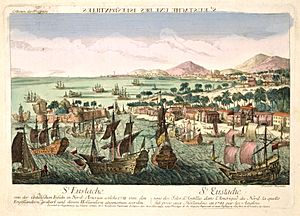Dutch West Indies campaign facts for kids
Quick facts for kids Dutch West Indies campaign |
|||||||
|---|---|---|---|---|---|---|---|
| Part of the Fourth Anglo-Dutch War | |||||||
 Île de Saint Eustache en 1781, Unknown author |
|||||||
|
|||||||
| Belligerents | |||||||
| Commanders and leaders | |||||||
The Dutch West Indies campaign was a series of small conflicts that took place in 1781 and 1782. These events were part of two larger wars happening at the time: the Fourth Anglo-Dutch War and the American Revolutionary War. During this campaign, Great Britain tried to take control of several Dutch colonies in the West Indies (the Caribbean islands) and in South America.
Contents
What Was the Campaign About?
This campaign was a series of military actions. It involved the British navy and army trying to capture Dutch territories. These territories were important trading posts and colonies. The main goal for Britain was to weaken the Dutch Republic. The Dutch were helping the American colonists in their fight for independence.
Why Did It Happen?
The campaign started because Great Britain declared war on the Dutch Republic in December 1780. This was the start of the Fourth Anglo-Dutch War. The Dutch Republic had been trading with and supporting the American colonists. The Americans were fighting for their freedom from British rule. Britain saw the Dutch actions as a threat. They wanted to stop this support and gain control of valuable Dutch trading centers.
Key Events of the Campaign
After the war was declared, British Admiral George Brydges Rodney quickly moved his forces. He was the commander of the Royal Navy in the West Indies.
- Capture of Sint Eustatius: In February 1781, Admiral Rodney captured Sint Eustatius. This island was a very important trading hub. It was a place where goods from France and the Netherlands were exchanged. Capturing it was a big blow to Dutch and French trade.
- Other Island Captures: Rodney also captured the nearby islands of Saba and Sint Maarten. These were smaller but still important Dutch colonies.
- South American Colonies: The British also took control of Dutch outposts in South America. These included Berbice, Demerara, and Essequibo. These areas were valuable for their resources.
A plan to attack Curaçao was called off. This happened because there were rumors that a French fleet was coming. The French were allies of the Dutch and the Americans.
The End of the Campaign
In 1782, a French expedition managed to recapture Demerara and Essequibo. The fate of the other captured colonies was decided later. This happened when the war officially ended. The final outcome of the campaign was "Status quo ante bellum." This means that things went back to how they were before the war started. The territories were returned to their original owners.

